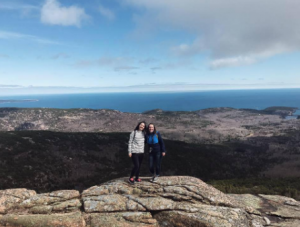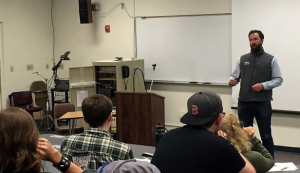
May 1, 2017 | Feature |
By Sofia Vanoli, Contributing Writer

Sofia Vanoli on the Mainely Outdoors adventure to Acadia National Park. (Photo by Patty Smith)
A timid sun shone for the 20 UMF students who participated in the annual trip to Acadia National Park Sunday, April 23. Mainely Outdoors hosted this annual excursion for the fourth time, this year with the largest number of participants to date, including five international students and a foreign professor.
James Toner, Director of the Fitness & Recreation Center and leader of the trip, said that it is surprising that many people have never been to a National Park before. “The Acadia trip is a special one as it provides an opportunity to visit our State’s National Park and all of its unique features,” Toner said. “It is particularly popular for international students.”
After a two and a half hour ride, the three school vans were filled with excitement and we were all ready to start the adventure. Some of us, who did not do any prior research on the park, thought we were surrounded by a big lake – or it might have only been me.
The Atlantic Ocean washed the coasts of Mount Desert Island, where most of the park is located. Brown sugar sand, dark green seaweeds and kelps, and courageous waves crashing on the beach were our first breathtaking scenery at Sand Beach. “What a creative name,” Patty Smith, senior and one of the three trip leaders, said ironically. Group pictures and funny poses took place with a still overcast sky.
After a short but fun hike on a rocky hill covered with white birches and green pines, we got a better view of the ocean which made me wonder how far home was.
Thunder Hole was our next stop. You could hear the sound of the waves smashing against the rocky coast and emitting a loud roar when booming into the cave of the Thunder Hole. Toner’s first rule is ‘safety is a priority,’ so he made sure that the group was careful when watching the waves crash forcefully. But nature made sure that our experienced trip leader got soaked by a bold wave that splashed next to him.
Driving to the top of Cadillac Mountain, the sun started to shine for us. Rays of light hitting the islands and an endless view were the protagonists of our photos. This was the best spot to finish our adventure.

Eva Schneider and Hannah Carlson enjoying the view. (Photo by Demi Dai)
Eva Schneider, French Language Teacher Assistant, took this opportunity to visit a National Park and to know more about Maine. “I was amazed by the view from Cadillac Mountain and I loved being at the top of the mountain,” Schneider said.
It’s no wonder why this is such a popular trip and fills up every time. Toner said, “A wide variety of programs were offered with a good response to nearly all of them.”
Some senior students joined the trip to take a break from their capstones and graduation responsibilities. “As a senior I wanted to make multiple trips and embrace the opportunity,” said international and global studies major, Sarah Gould. “I’m glad I came with my friends and enjoyed the fresh air and the sun instead of being locked up in a room.”
The trip was an exceptional one with different landscapes in the same area, something you do not want to miss if you are new to Maine. However, some of us wished we had hiked the wooded areas where trails disappeared between the trees or climbed the rocky mountains the park has to offer.

May 1, 2017 | News |
By Jessica McKenna, Contributing Writer

Lucas St.Clair speaks at UMF about developing Katahdin Woods and Water National Monument. (Photo by Jessica McKenna)
Students, faculty, and community members slowly trickled into the C-23 auditorium in Roberts recently to learn first-hand the story of how Katahdin Woods and Water National Monument became a reality from speaker Lucas St. Clair, son of well-known Burt’s Bees co-founder Roxanne Quimby. St. Clair’s family donated the 87,500 acres comprising the monument which was officially designated by President Obama last summer, following a lengthy local debate over the issue. St. Clair used his time to explain the long road leading up to their recent success.
The room went completely dark with the only light coming from the projector screen, a small kerosene lamp was lit and brought the audience from day to night as they witnessed a journey through Katahdin Woods and Water National Monument. The lights came up and Lucas St. Clair stood before the audience in a blue checkered dress shirt and jeans that were worn around the pockets outlining his wallet and phone. He wasted no time jumping into his family’s history and stories of growing up in a hand built log cabin with no water or electricity in Dover-Foxcroft. His mother and father moved from the West Coast to Maine in the 1950s buying 60 acres of land in Piscataquis County classifying themselves as “hippies”.
While attending Gould Academy in Bethel, St. Clair found his passion for the outdoors. “I spent more time outside than in the classroom,” he said. This passion lead him to hike the Appalachian Trail. While hiking through the 100-mile wilderness in Maine, St. Clair found that the long stretch from Baxter State Park to Monson was not truly wild. The family decided to start a plan to protect and preserve the natural beauty of the Maine woods.
Fear and anxiety swept through Maine’s small towns when a proposed map of the park was released to the public. In 2001 Roxanne Quimby had a meeting to discuss the park with Governor Angus King on Sept 11. The meeting was cut short due to the terrorist attacks and Quimby took that as a sign to put the park on hold. After selling Burt’s Bee’s she started mapping out a revised version of the proposed park. Yet again she was met with opposition when local newspapers labeled her as an out-of-stater bad mouthing Maine on a national level. This was the last straw and Quimby turned the fight over to her son Lucas with a deadline of the 100th anniversary of the National Parks Service.
St. Clair spent his time talking to locals and compiling reports about Maine recreation and the economics of surrounding towns. “I basically camped out in the Katahdin region for four years,” said St. Clair, explaining his efforts to talk to people and gather support for the project. Through these informal talks St. Clair found out the wants and needs of the towns and its people and that of the Native American tribes in the area. A bill was drafted for the park but failed in the legislature.
St. Clair turned his sights towards the Obama Administration and asked for help through the use of the Antiquities Act to establish the park. A five-hour public meeting was held in Orono with 1,400 in attendance. “I had many people poking their fingers in my chest telling me I was ruining their community,” said St. Clair. The meeting concluded with the majority being in support of the park with only 12 of the 450 comment cards opposing.
The White House and St. Clair then entered the legal minefield of right-of-way and liability issues that accompanied the donation of the land to the government. The park was finally established and is the only national park that allows hunting, truly catering to the Maine communities that surround it.
Professor Linda Beck, who organized the talk with St. Clair, attended with her Environmental Politics class and said, “Some (students) were actually quite surprised, they had anticipated not liking or agreeing with him but found his presentation and story quite compelling.”
Throughout the talk laptop keys were clicking at rapid fire and pages of notepads were filled as quickly as they could be turned. Students and professors struggled to record the enthralling story. Professor Wendy Harper attended the talk with her Environmental & Resource Economics class and was pleased with how St. Clair’s story could influence her students. “I think students always benefit when they hear from folks who make things happen,” she said, “particularly those who “learn by doing” and have a great passion for their work.”
In recent news, while establishment of the park was secured under the Obama administration’s use of the Antiquities Act, according to a report from the Portland Press Herald, there is a possibility that the designation could be reviewed by the Trump administration along with a list other monuments. While there were conflicting comments from the Department of the Interior regarding whether or not the Katahdin monument is on this list, St. Clair says that he is confident that the project would stand on its own merits even if reviewed.


